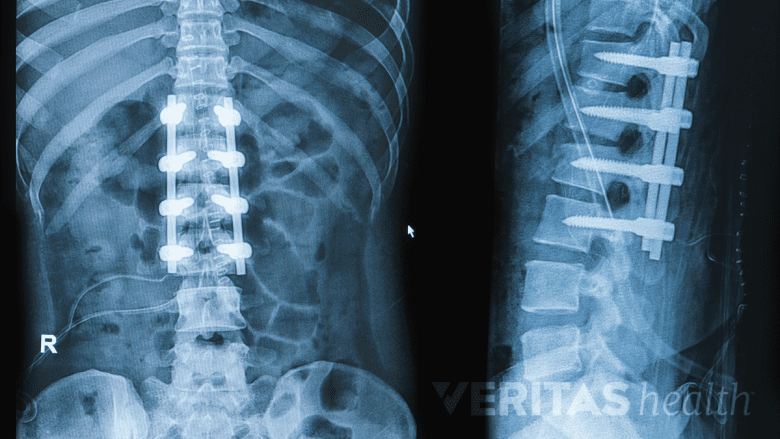Robotic spine surgery is a relatively new technology that involves the use of robots to assist in surgical procedures on the spine. These surgeries are gaining popularity due to their numerous potential benefits, but like any surgical procedure, they also carry several potential risks.
Potential Advantages and Benefits of Robot-Assisted Surgeries

Robot-assisted surgeries may offer better precision in some spinal surgeries.
Robotic technology offers potential benefits for both surgeons and patients, including:
Improved precision
Robotic spine surgery was developed for increased accuracy and precision. The robot can be programmed to navigate through the intricate structures of the spine with ease, and this precision ensures that the surgeon can perform the surgery with a level of accuracy that may be difficult to achieve with traditional surgical methods.1D'Souza M, Gendreau J, Feng A, Kim LH, Ho AL, Veeravagu A. Robotic-Assisted Spine Surgery: History, Efficacy, Cost, And Future Trends [published correction appears in Robot Surg. 2019 Dec 23;6:25]. Robot Surg. 2019;6:9-23. Published 2019 Nov 7. doi:10.2147/RSRR.S190720
Smaller incisions
Robotic spine surgery typically requires smaller incisions than traditional surgery, minimizing the separation of muscle tissue and thereby reducing the risk of related complications.2Vo CD, Jiang B, Azad TD, Crawford NR, Bydon A, Theodore N. Robotic Spine Surgery: Current State in Minimally Invasive Surgery. Global Spine J. 2020;10(2 Suppl):34S-40S. doi:10.1177/2192568219878131
Shorter operative time
Limited data suggest that robotic surgeries may take 36% to 56% lesser time compared to traditional free-hand surgery.3Fiani B, Quadri SA, Farooqui M, et al. Impact of robot-assisted spine surgery on health care quality and neurosurgical economics: A systemic review. Neurosurg Rev. 2020;43(1):17-25. doi:10.1007/s10143-018-0971-z
Less exposure to radiation
Minimally invasive surgeries involve the use of fluoroscopic (live x-ray) guidance to help the surgeon clearly view the surgical field. The use of fluoroscopy places the surgeon and the operating staff at a high risk of exposure to radiation. Robotic surgeries do not rely on fluoroscopy—and can still provide a clear and enhanced view of the surgical field.3Fiani B, Quadri SA, Farooqui M, et al. Impact of robot-assisted spine surgery on health care quality and neurosurgical economics: A systemic review. Neurosurg Rev. 2020;43(1):17-25. doi:10.1007/s10143-018-0971-z
Quicker recovery time
The use of smaller incisions and less tissue damage may result in a quicker recovery time for patients.1D'Souza M, Gendreau J, Feng A, Kim LH, Ho AL, Veeravagu A. Robotic-Assisted Spine Surgery: History, Efficacy, Cost, And Future Trends [published correction appears in Robot Surg. 2019 Dec 23;6:25]. Robot Surg. 2019;6:9-23. Published 2019 Nov 7. doi:10.2147/RSRR.S190720 As a result, patients may be able to resume their usual activities sooner compared to those who undergo traditional surgery. Studies evaluating post-surgical healing and recovery have shown minimal disruption to muscle tissue with robot-assisted technology, which could lead to less pain, lower rates of muscle strain, and reduced stiffness during the recovery and healing period.3Fiani B, Quadri SA, Farooqui M, et al. Impact of robot-assisted spine surgery on health care quality and neurosurgical economics: A systemic review. Neurosurg Rev. 2020;43(1):17-25. doi:10.1007/s10143-018-0971-z
Reduced risk of complications

Robot-assisted surgeries may reduce the risks associated with pedicle screws and rods.
A highly controlled surgical approach is possible with robotic assistance, which may help in the more accurate placement of spinal instrumentation, such as pedicle screws, lowering the rate of complications associated with the placement of such instrumentation in the spine.1D'Souza M, Gendreau J, Feng A, Kim LH, Ho AL, Veeravagu A. Robotic-Assisted Spine Surgery: History, Efficacy, Cost, And Future Trends [published correction appears in Robot Surg. 2019 Dec 23;6:25]. Robot Surg. 2019;6:9-23. Published 2019 Nov 7. doi:10.2147/RSRR.S190720
However, there is inconclusive research on the effectiveness of these surgeries. Some studies have stated reduced complications by approximately 48% when comparing robot-assisted spine surgeries to traditional surgeries,3Fiani B, Quadri SA, Farooqui M, et al. Impact of robot-assisted spine surgery on health care quality and neurosurgical economics: A systemic review. Neurosurg Rev. 2020;43(1):17-25. doi:10.1007/s10143-018-0971-z while others have reported higher rates of complications in certain types of robot-assisted surgeries, such as lumbar fusion surgery.4Passias PG, Brown AE, Alas H, et al. A cost benefit analysis of increasing surgical technology in lumbar spine fusion. Spine J. 2021;21(2):193-201. doi:10.1016/j.spinee.2020.10.012
Lower rates of revision surgeries
Revision surgeries are done when the goals of the initial procedure are not met or if a complication needs to be corrected. A study comparing traditional versus robot-assisted surgery in 112 cases reported lesser revision in robotic surgeries by 46%. Revision surgeries are challenging to the patient and the surgeon, and often, the cost of revision surgeries is not covered by insurance and must be incurred by the hospital, institution, or surgeon.3Fiani B, Quadri SA, Farooqui M, et al. Impact of robot-assisted spine surgery on health care quality and neurosurgical economics: A systemic review. Neurosurg Rev. 2020;43(1):17-25. doi:10.1007/s10143-018-0971-z
In This Article:
- What You Need to Know About Robotic Spine Surgery
- Potential Advantages and Disadvantages of Robotic Spine Surgery
Comparing the Advantages of Robotic Spine Surgeries to Traditional Spine Surgeries
Research suggest that several advantages of robotic spine surgery have already been realized with existing minimally invasive surgical techniques and technology.5Huang J, Li Y, Huang L. Spine surgical robotics: review of the current application and disadvantages for future perspectives. J Robotic Surg. 2020;14(1):11-16. doi:10.1007/s11701-019-00983-6
It is important to note that surgical robots in spine surgery are completely dependent on imaging and navigation before and during the surgery. Navigation is the critical technology independent of the robot.3Fiani B, Quadri SA, Farooqui M, et al. Impact of robot-assisted spine surgery on health care quality and neurosurgical economics: A systemic review. Neurosurg Rev. 2020;43(1):17-25. doi:10.1007/s10143-018-0971-z On the other hand, surgeries performed traditionally have shown similar accuracy, precision, minimal incisions, soft tissue sparing, minimal blood loss, reduced surgical time, and reduced radiation exposure.5Huang J, Li Y, Huang L. Spine surgical robotics: review of the current application and disadvantages for future perspectives. J Robotic Surg. 2020;14(1):11-16. doi:10.1007/s11701-019-00983-6
Potential Disadvantages and Risks of Robot-Assisted Surgeries

Equipment malfunction in robotic spine surgeries can damage the spinal nerves or spinal cord.
Human error and mechanical failure are a few disadvantages and risks of robotic surgeries. Other potential disadvantages include:
High cost
Robotic spine surgery can be expensive, and many insurance plans may not cover the cost. This problem can make it difficult for some patients to afford the procedure.1D'Souza M, Gendreau J, Feng A, Kim LH, Ho AL, Veeravagu A. Robotic-Assisted Spine Surgery: History, Efficacy, Cost, And Future Trends [published correction appears in Robot Surg. 2019 Dec 23;6:25]. Robot Surg. 2019;6:9-23. Published 2019 Nov 7. doi:10.2147/RSRR.S190720
While the pre-surgical planning facilitated by a surgical robot may be useful in complex spine surgeries, such as in treating spinal deformities, revision surgeries, or tumor procedures, it is difficult to justify the high cost of using a spinal robot for surgeries performed on one or two spinal segments.
Limited availability of expertise
Robotic spine surgery technology is not yet widely available, and it may be difficult for patients to find a surgeon who is experienced in performing the procedure.
Potential for equipment malfunction
Like any technology, the robot used in robotic spine surgery has the potential for malfunction and failure. This risk can lead to surgical errors or other complications, such as accidental tissue or nerve injuries.
Limited data on the effectiveness of the technology
Because robotic spine surgery is a relatively new technique, there is limited data on its long-term effectiveness. While early results may seem promising, more research is needed to fully understand the benefits and risks of the procedure.1D'Souza M, Gendreau J, Feng A, Kim LH, Ho AL, Veeravagu A. Robotic-Assisted Spine Surgery: History, Efficacy, Cost, And Future Trends [published correction appears in Robot Surg. 2019 Dec 23;6:25]. Robot Surg. 2019;6:9-23. Published 2019 Nov 7. doi:10.2147/RSRR.S190720
Too expensive for ambulatory surgical centers
A significant amount of spine surgery is moving to the ambulatory setting to pair high-quality care with lower overall costs.6DelSole EM, Makanji HS, Kurd MF. Current trends in ambulatory spine surgery: a systematic review. J Spine Surg. 2019;5(Suppl 2):S124-S132. doi:10.21037/jss.2019.04.12
Currently, spine surgical robots are too expensive for ambulatory surgical centers (ASC). Research indicates that for select patients, ASCs have successfully performed minimally invasive spinal fusion surgeries and lumbar decompression with patients discharged the same day and a low reported risk of complication.6DelSole EM, Makanji HS, Kurd MF. Current trends in ambulatory spine surgery: a systematic review. J Spine Surg. 2019;5(Suppl 2):S124-S132. doi:10.21037/jss.2019.04.12
- 1 D'Souza M, Gendreau J, Feng A, Kim LH, Ho AL, Veeravagu A. Robotic-Assisted Spine Surgery: History, Efficacy, Cost, And Future Trends [published correction appears in Robot Surg. 2019 Dec 23;6:25]. Robot Surg. 2019;6:9-23. Published 2019 Nov 7. doi:10.2147/RSRR.S190720
- 2 Vo CD, Jiang B, Azad TD, Crawford NR, Bydon A, Theodore N. Robotic Spine Surgery: Current State in Minimally Invasive Surgery. Global Spine J. 2020;10(2 Suppl):34S-40S. doi:10.1177/2192568219878131
- 3 Fiani B, Quadri SA, Farooqui M, et al. Impact of robot-assisted spine surgery on health care quality and neurosurgical economics: A systemic review. Neurosurg Rev. 2020;43(1):17-25. doi:10.1007/s10143-018-0971-z
- 4 Passias PG, Brown AE, Alas H, et al. A cost benefit analysis of increasing surgical technology in lumbar spine fusion. Spine J. 2021;21(2):193-201. doi:10.1016/j.spinee.2020.10.012
- 5 Huang J, Li Y, Huang L. Spine surgical robotics: review of the current application and disadvantages for future perspectives. J Robotic Surg. 2020;14(1):11-16. doi:10.1007/s11701-019-00983-6
- 6 DelSole EM, Makanji HS, Kurd MF. Current trends in ambulatory spine surgery: a systematic review. J Spine Surg. 2019;5(Suppl 2):S124-S132. doi:10.21037/jss.2019.04.12

